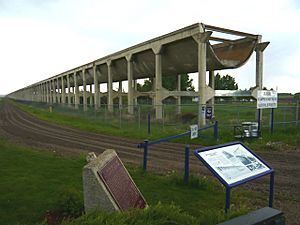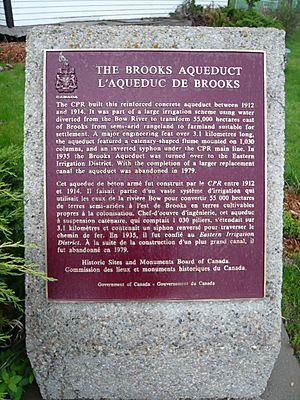Brooks Aqueduct facts for kids
Quick facts for kids Brooks Aqueduct |
|
|---|---|
 |
|
| Type | aqueduct |
| Location | Brooks, Alberta, Canada |
| Nearest city | County of Newell |
| Built | 1912–1914 |
| Original use | Aqueduct |
| Governing body | Parks Canada |
| Website | Brooks Aqueduct |
| Official name: Brooks Aqueduct National Historic Site of Canada | |
| Designated | 18 November 1983 |
| Official name: Brooks Aqueduct | |
| Designated | 20 July 2000 |
| Lua error in Module:Location_map at line 420: attempt to index field 'wikibase' (a nil value). | |
The Brooks Aqueduct is an old structure that used to carry water. It is now a historic site and a museum. The Canadian Pacific Railway Company built it in the early 1910s. It is located in Southern Alberta, Canada.
The aqueduct was made to bring water for irrigation to farms. It moved water from Lake Newell to a part of southeastern Alberta. It worked from 1914 to 1979. The aqueduct is about 8 kilometres south of the City of Brooks. The main part of the aqueduct is 3.2 kilometres long. It stands about 20 metres high. Today, it is a National Historic Site. There is also a visitor centre nearby for people to learn about it.
Contents
Building the Brooks Aqueduct
The Canadian Pacific Railway (CPR) wanted to bring water to a dry area. This area was called Palliser's Triangle in southern Alberta. The CPR had received a large piece of land. This land was given to them for building the cross-Canada railway. They needed to make this land good for farming.
Why an Aqueduct Was Needed
Hugh B. Muckleston was an engineer for the CPR. He realized that a simple dirt canal would not work. The land was too uneven and difficult. So, he thought of building a special structure to carry the water. This structure became the Brooks Aqueduct.
How the Aqueduct Was Designed
The aqueduct was built using strong reinforced concrete. It was designed as an open channel, like a big trough. This channel was shaped in a special curve called a catenary. This shape helped it carry the water efficiently.
The design also included "expansion joints." These joints were made mostly of copper. They were placed every 24 metres (80 feet). These joints allowed the long aqueduct to expand and shrink. This movement happens because of temperature changes.
To cross under the main Canadian Pacific Railway tracks, a siphon was built. A siphon is a pipe that uses water pressure to move water. This one worked using the Venturi principle. It carried water about 40 feet under the railway.
Construction and Early Use
The company Grant, Smith & Co. & McDonnell built the aqueduct. Construction happened between 1912 and 1914. When it was finished in 1914, it cost about CA$700,000. It began working in 1915. At that time, it was said to be the largest concrete structure ever built.
Challenges and Changes
After it was built, the copper expansion joints leaked a lot. This caused damage to the concrete supports. Workers tried to fix the leaks and built drainage ditches. The water itself also caused problems. The water's alkalinity (how basic it was) and frost damaged the concrete over time.
Repairs and New Ownership
The Canadian Pacific Railway kept repairing the aqueduct. They sprayed a special concrete mix called "gunnite" on the damaged parts. These repairs happened through the 1920s and early 1930s.
In 1934, the Brooks Aqueduct was given to the Eastern Irrigation District. This was a group of farmers. They took over the aqueduct in 1935. The aqueduct was used for irrigation for about 30 more years. It could carry a lot of water, about 900 cubic feet per second. It helped bring water to 113,000 hectares of land. This led to many new people settling in the area.
Why It Was Replaced
In 1969, the governments of Alberta and Canada took over the aqueduct. They checked the aqueduct and the nearby Bassano Dam. They found that the dam needed only small repairs. But the aqueduct was no longer safe to use.
Instead of fixing the aqueduct, new dirt canals were built. These canals took over the job of carrying water. The governments then decided it was cheaper to fence off the old aqueduct. It was too expensive to tear it down.
Brooks Aqueduct Today
The Brooks Aqueduct still stands today. However, it is not safe to go on it. It has been fenced off since the 1970s.
The Government of Canada made the Brooks Aqueduct a National Historic Site of Canada. This happened on November 18, 1983. Later, on July 20, 2000, the Government of Alberta also named it a Provincial Historical Resource. This means it is an important part of history for both Canada and Alberta.
See also
 In Spanish: Acueducto Brooks para niños
In Spanish: Acueducto Brooks para niños


